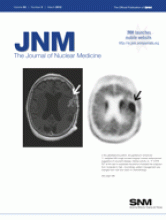TO THE EDITOR: The recent interesting and highly relevant article by Brockenbrough et al. (1) includes a significant methodologic misconception and mistake regarding PET measurements of tissue radiotracer uptake. On page 1183, column 1, final paragraph, the authors state “KFLT was not partial-volume–corrected because it represents a net movement over time of 18F-FLT through tissue compartments, with all time frames equally affected by partial-volume effect, and these are accounted for by the method defining the region of interest (full width at half maximum).”
The region-of-interest technique used to obtain tumor time–activity curves (lower threshold = 50% of maximum voxel standardized uptake value) could not have compensated for the partial-volume effect (2). Uncorrected partial-volume effect would have introduced negative errors in measurements of standardized uptake value over time. Those errors would have varied from tumor to tumor within and among patients.
The flux parameter KFLT (units of mL/min/g of tissue) is the clearance of 3′-deoxy-3′-18F-fluorothymidine (18F-FLT) from blood into 18F-FLT nucleotides within the tissue included in the region of interest. In terms of model rate coefficients, KFLT = K1k3/(k2 + k3). A straightforward examination of the differential equations for the kinetic model and that relating the PET signal to the model (3) shows that any error in measured standardized uptake value produces a proportional error in K1. Since the kinetic parameters are correlated, that error would also propagate from K1 to the other model parameters (3).
Accurate absolute image quantitation is no less essential for kinetic modeling than for static uptake measurements. To the extent that partial-volume effect varied among tumors, failure to correct for it may obscure the authors’ analyses of relationships between KFLT and tumor thymidine kinase-1 or Ki-67 (Fig. 5; Tables 4 and 5).
Partial-volume correction for tumor images large enough to demonstrate irregular shapes or heterogeneous image intensity is a difficult and as yet unsolved problem (4). Although it may not have been feasible for the authors to make such corrections, they should have acknowledged the problem and its potential impact on their findings.
Footnotes
Published online Jan. 31, 2012.
- © 2012 by the Society of Nuclear Medicine, Inc.







